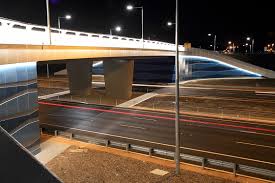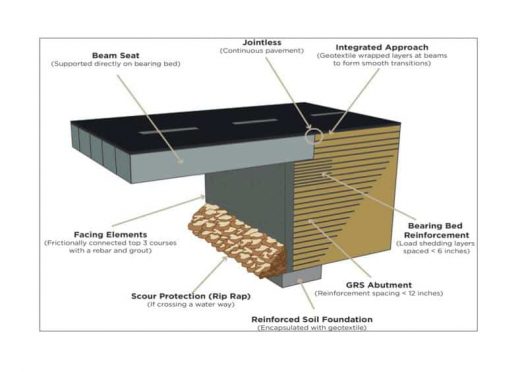What is Bridge Abutment?
The bridge abutment is crucial at the bridge’s end, supporting the bridge’s superstructure. It also links to the ground-level road and supports the bridge via the abutment. The infill material supports the bridge path.
The location of the site and the function of the need determine which abutment is utilized in the bridge. Abutment comes in a variety of shapes and sizes. The use of an abutment is determined by the cost and type of the abutment concerning the site location.

Fig 1: Bridge Abutment
Courtesy: terre-armee.com
The Function of Bridge Abutment:
- It transfers the load on the bridge and the wind load from its dead weight to the earth by using the bridge abutment.
- .The abutment transfers load from the superstructure to the foundation components.
- By supporting one edge of the approach slab, abutment aids in the safe landing.
- In arch bridges, abutments provide stability between vertical and horizontal force elements.
Parts of Bridge Abutment:

Fig 2: Parts of Bridge Abutment
Courtesy: civiconcept.com
1. Bridge Seat:
A horizontal shelf near or on an abutment supports the bridge deck. These would be used to secure the end of a bridge on the embankment, while those placed along a span would provide support to alleviate long-term stress.
2. Wing Wall:
This part of the abutment is only for the embankment. This aids in the maintenance of the bridge’s side slope embankment. It also protects the barrier from erosion by using short retaining walls.
3. Back Wall:
In a bridge abutment, back walls are utilized to support the embankment. According to the embankment’s slope, the side walls are built vertically at the bridge’s edge. The back walls support the bridge deck’s extension joints.
4. Abutment Pile:
The abutment’s pile is the filament that is connected to the abutment’s foundation utilizing the bridge’s seat. The length of the pile is determined by the bridge’s height and the obstruction’s depth (canal, river, and stream).
5. Footing of Abutment:
This element of an abutment has normally buried the ground and connects the vertical, load-bearing portion of the abutment to the ground. For distributes the weight; it consists of a horizontal surface that is sometimes wider than the bridge.
Types of Bridge Abutment:
1. Gravity Abutment:
This kind of abutment has a substantial foundation. This sort of abutment’s dead weight can bear water pressure and Earth pressure. The gravity abutment’s structure rests directly on the ground. The earth’s gravitational force keeps it on the ground due to its weight.
2. U-shaped Gravity Abutment:
The wings of this kind of bridge abutment are perpendicular to the face and serve as counter-forts. These abutments are extremely durable. The abutment’s wing walls are perpendicular to the bridge’s seat at a 90-degree angle. A U-shaped Abutment is made up of two piles located evenly across the width of the bridges. These sorts of abutments are made of reinforced cement concrete. Both abutment piles are joined at the bottom by a foundation. Both heaps have the same foot.
3. Stub Abutment:
A stub abutment, also known as a perched abutment, is a relatively short abutment built after completing the embankment. The embankment can be compacted without the abutment interfering, and the abutment building can be delayed if necessary. These abutments are as short as possible and placed at the top of fill embankments. Stub abutments usually only hold slightly thick soils than the thickness of the superstructure.
Although stub abutments are cost-effective, they tend to lengthen the end spans. Additional wall abutments can be significantly taller than the crossing itself, and they are frequently built to the full height of the crossing.
4. Semi-Stub Abutment:
The semi-stub abutment is halfway between full-height and stub-abutment heights. Unlike stub abutments constructed on the top of the embankment, the full-height abutment is constructed at the bottom. Between the top and bottom of the embankments, these abutments are constructed. They are known as Semi-Stub abutments because they are larger than stub abutments and shorter than full-height abutments.
5. Cantilever Wall Abutments:
A Cantilever Abutment serves multiple functions: one is to retain soil behind the bridge’s ends, and the other supports the bridge superstructure. Stub abutments are the name given to some types of wall abutments. These abutments are installed at the top of fill embankments and are designed to be as short as feasible. Stub abutments frequently only hold somewhat higher soils than the superstructure’s thickness.
Stub abutments can be highly cost-effective, but they tend to lengthen the end spans. Other wall abutments are often built to the full height of the crossing and can be much taller. Full-height abutments are more complex to construct, but they have shorter end spans.
6. Full Height Abutments:
This type of abutment is common in congested and metropolitan regions where structural depth is required. It’s essentially a high-height abutment for low-level roadways built to sustain the entire construction.
7. Counter-fort Abutment
The counter-fort abutment serves as a retaining wall for the counter-fort. A thin wall called the main counter-fort connects the wall to the footing in the counter-fort abutment. At regular intervals, these counter-fort walls are constructed.
8. Mechanically Stabilized Abutment:
Mechanically stabilized walls have also supported bridge abutments. As indicated schematically in the accompanying image, the bridge seat and footing are supported directly on the reinforced backfill. The mechanically stabilized wall design concepts are applicable. The need for reinforcing is heightened by abutment loads, particularly in the upper section of the backfill, where the bridge loads are concentrated. The Moselle River Bridge at Thionville, France, rarely used this abutment design.
9. Spill-Through Abutment:
Spill-through abutments are a form of abutment that is short and stubby. Pedestals or columns that reach the natural ground support this form of the abutment. This form of abutment, like closed abutments must be built before the building is constructed. The fill is put on both sides of the pedestals simultaneously to reduce unbalanced earth pressure and abutment lateral displacement. The fill around the pedestals, on the other hand, is extremely difficult to compact properly. It’s also prone to erosion unless the final slope is covered with asphalt, riprap, or other means.
10. Pile Bent Abutment:
This kind of abutment is utilized to replace the wall-like support structure. It is essentially a sequence of piles or columns that offer structural support.
Design Considerations of Bridge Abutment:
The following factors are taken into account when planning the bridge abutment:
- Differential settling of the approach slab and the bridge deck is restricted, as it could provide a trip hazard and detract from the road’s aesthetics.
- Prevent shear failures in the approach slab owing to poor soils; fill from the bridge abutment excavation or other circumstances.
- Enlarge the subsurface layout to the road subsurface as needed to avoid the freshly dug area for the bridge abutment’s construction.
- The length of the approach slab must be appropriate for the bridge deck width and abutment height, as determined by a certified competent structural engineer.
- Set the approach slab into a suitable-sized notch in the bridge abutment to join the approach slab to the bridge abutment. As needed, secure with anchors.
- Suitably compacted soil, aggregate, and flow able fill shall be present beneath the approach slab.
- It is possible to employ a long-term seamless transition from the approach slab to the bridge deck while avoiding shear failure in the approach slab. A skilled designer must design an alternative technique.
Conclusion
A bridge abutment is a structure that joins the bridge’s deck to the ground at the ends of a bridge span, assisting in the horizontal and vertical support of the bridge’s weight.
References
1. What Is Bridge Abutment? | Uses of Bridge Abutment | Components of Bridge Abutment | Type of Abutment. (2021, June 22). 9To5Civil; 9to5civil.com. https://9to5civil.com/bridge-abutment/
2. Rajput, K. (2022, January 25). What Is Bridge Abutment | 5 Types of Abutments. CivilJungle; civiljungle.com. https://civiljungle.com/what-is-bridge-abutment/
3. Bridge Abutments and their ten types – CivilEngineeringBible.com. (n.d.). CivilEngineeringBible.Com; civilengineeringbible.com. Retrieved April 18, 2022, from https://civilengineeringbible.com/article.php?i=261
4. Bridge Abutment: Design, Types & Examples – Video & Lesson Transcript | Study.com. (2022, January 11). Study.Com; study.com. https://study.com/academy/lesson/bridge-abutment-design-types-examples.html
5. Mahajan, B. (2021, June 11). Bridge Abutment | 10 Types of Abutments | 10 Bridge Abutment Types | Abutment Bridge. Civiconcepts; civiconcepts.com. https://civiconcepts.com/blog/bridge-abutment
6. Types of Bridge Abutments | Bridge Abutment Design. (n.d.). Types of Bridge Abutments | Bridge Abutment Design; www.constructioncost.co. Retrieved April 18, 2022, from https://www.constructioncost.co/bridge-abutment.html
7. Selection and Types Abutments. (2018, March 16). Online Civil Forum; www.onlinecivilforum.com. https://www.onlinecivilforum.com/site/selection-and-types-abutments/
If you have a query, you can ask a question here.


